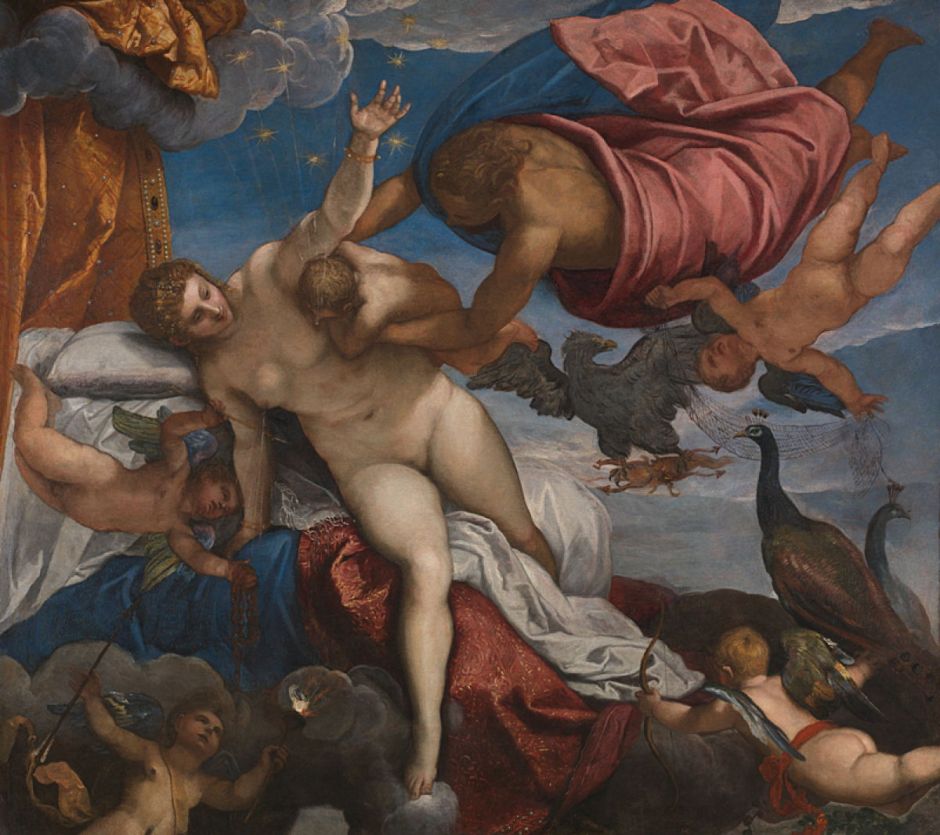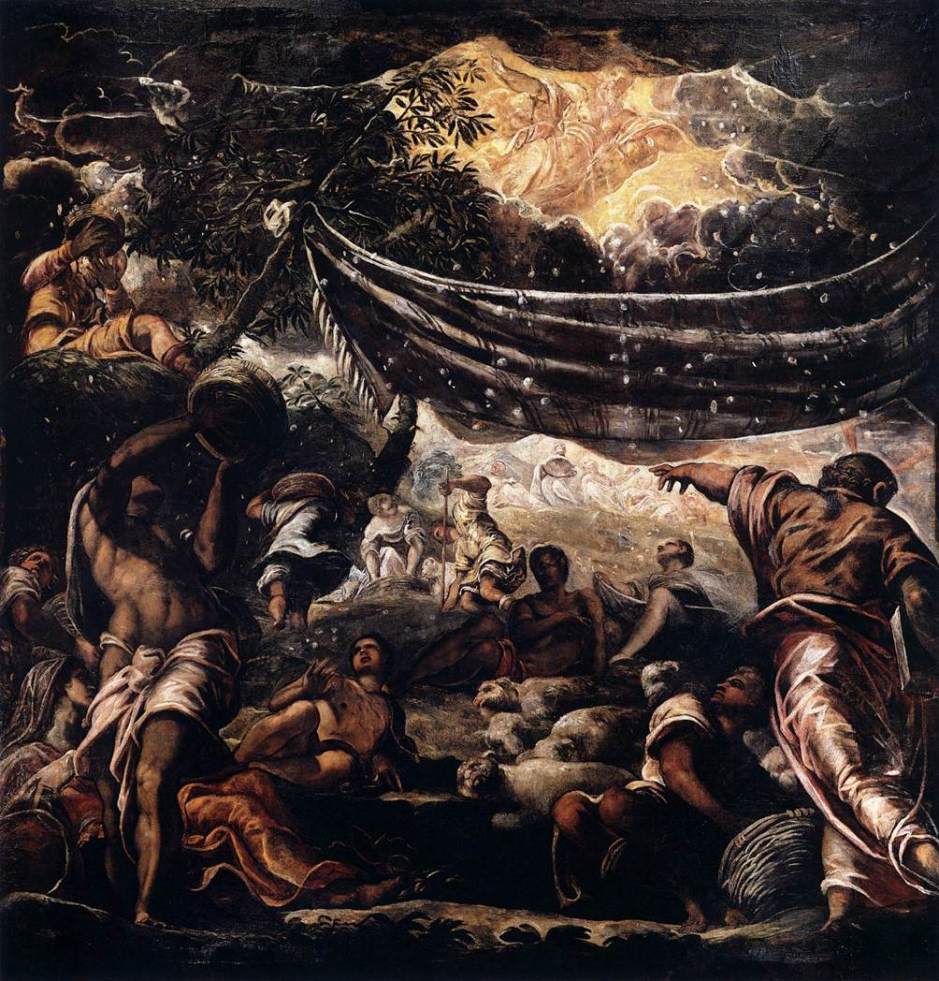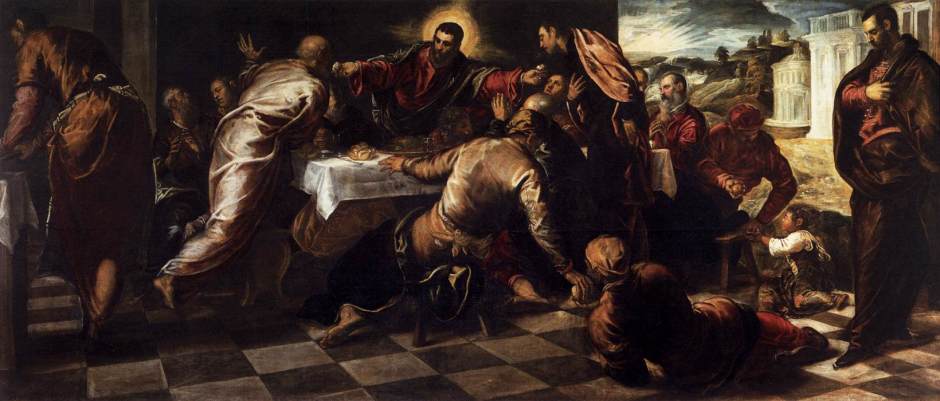This year we might be celebrating a very special anniversary: half a millenium has passed since the birth of Tintoretto, one of the great Masters of Venice.
I write might, because there is considerable uncertainty as to the date of his birth. He was probably born towards the end of September, or possibly in early October, of either 1518 or 1519. The current consensus among experts seems to be that the most likely date was about 29 September 1518, and most collections now give the year of his birth as 1518. So as far as this blog is concerned, that is when I will celebrate his birth.
Neither was he born with the name Tintoretto: when christened, he was called Jacopo Comin, although that surname was not revealed until 2007. As his father had been among those who had defended the city of Padua during the war of 1509-1516, his son was generally known as Jacopo Robusti. But he attracted another nickname, because his father was a dyer, that of Tintoretto, meaning ‘little dyer’.
Great artists come into vogue and fade back into history from time to time, often for no good reason. At present, Tintoretto is not particularly popular, and I cannot find any grand exhibitions of his work to mark this grand anniversary, nor are there many new books being published to coincide with it.
I hope over the next couple of months to engender your enthusiasm for rediscovering one of the greatest painters of all time, as I look at some of his works.
Tintoretto was both famously and infamously a very rapid painter. Sebastiano del Piombo has been quoted as saying that Tintoretto could paint in two days as much as would have taken him two years to complete. Over the centuries since then, and particularly with the development of ‘painterly style’ in the nineteenth century, this would seem to be a virtue, and many of his paintings are surprisingly painterly for their time.
His speed was not always matched by the quality of his work, although this is confounded by its attribution. Some of the paintings produced by his workshop are clearly inferior to what we would expect of a Tintoretto, and this raises the question of which works he actually painted.
In Tintoretto’s case, it is exceedingly difficult to decide which works he really did paint. Like all major painters of the time, most of the works now associated with him came not from his hand, but from his workshop. In some cases, Jacopo Tintoretto himself is thought to have developed the composition, made any studies, and wielded the brushes with which the painting was made. At the other extreme are works with which Jacopo himself may have had little or no involvement, which were planned by his son Domenico, and painted by others in the workshop.
Normally, a group of experts would review all the evidence for each painting which could be attributed to an artist, and publish their evidence and conclusions in a catalogue raisonné, which would then become authoritative, at least until the next one. In Tintoretto’s case, the closest that we currently have to this is a paper by Echols and Ilchman (2009) providing a checklist of attributions, which I will refer to as E&I.

Catalogues raisonnés are often controversial, and bring some surprises, and some disappointments. One of my favourite works previously attributed to Jacopo Tintoretto, Athena and Arachne from 1543-44, is now deemed not to be his, although it is suggested that he may have designed it.
Tintoretto was born in the city of Venice, lived in it for almost his entire life, and died there on 31 May 1594, at the age of 75. Although he seems to have studied briefly in Titian’s workshop, he was largely self-taught. He naturally struggled to make ends meet at first, but when he was commissioned to undertake four major works for the Scuola Grande di San Marco in 1548, his reputation was established and he would never again go without work.

As early as 1541, when he was just 23, Tintoretto painted a ceiling ensemble for the Ca’ Pisani a San Paternian showing fourteen scenes from Ovid’s Metamorphoses, among them Jupiter and Europa (E&I 26). Being viewed from below, he had to master difficult perspective projections and great foreshortening for them to have full visual effect.

Among the best of his earlier mature works is this brilliant combination of religious myth and landscape, showing Saint George and the Dragon (c 1555) (E&I 62), in which he also exploited an optical illusion which wasn’t discovered outside the world of art for another 450 years.

Although many of his paintings are portraits, or religious works, Tintoretto is one of the most innovative visual artists when telling stories. Here he shows the mythical Origin of the Milky Way (1577-79) (E&I 213), which resulted from the milk which gushed in fine streams into the heavens when the infant Hercules was pulled from Juno’s breast.

Another of the many paintings which he made for the Scuolo Grande di San Rocco in Venice, for the ceiling of the Sala Superiore there, shows the Gathering of the Manna (1577) (E&I 175) of the Israelites, when they wandered for forty years in the desert after their exodus from Egypt.

In his late account of the abduction of Helen by Paris, in The Rape of Helen (c 1578-79) (E&I 235), Tintoretto constructs a densely-populated scene of battle, a theme which returned frequently in his Gonzaga Cycle of paintings for the Palazzo Ducale in Mantua. That cycle is comparable in scale to Rubens’ allegorical cycles for Marie de’ Medici about fifty years later.

Finally, with the close involvement of his son Domenico and their workshop, Jacopo Tintoretto created his own vision of Paradise (1588-1592) (E&I 298) for the Sala del Maggior Consiglio in Venice’s Palazzo Ducale.
Many of Tintoretto’s paintings have remained in Venice since he created them over four hundred years ago. In many cases, this imposes additional problems: not only are these paintings extremely old, but they have been hung in a permanently damp atmosphere which is hot and wet in the summer, and cold and wet in the winter – which was the original impetus to the development of oil on canvas technique in Venetian art. It therefore isn’t surprising that some are now looking quite old, despite the devoted work of conservation experts over the years.
I hope that this small sample of Tintoretto’s work has tempted you to read and view future articles, as I look in more detail at his work.
Articles in series:

Thirteen of fourteen ceiling panels in Vettore Pisani’s palace at San Paternian, near San Marco in Venice, showing the Fables of Ovid, 1541-42.

Early religious works, Venus and Mars Surprised by Vulcan (c 1545), and his first real success, Miracle of the Slave (1548).

A portrait, self-portrait, religious works, and four scenes from the book of Genesis for the Scuola della Trinità.

Two masterpieces: Saint George and the Dragon and Susannah and the Elders.
5: First work for the Madonna dell’Orto

Religious works, including his first brilliant paintings for the Madonna dell’Orto, where he was buried.

Crucifixion (c 1558), The Last Judgment and Making of the Golden Calf for the Madonna dell’Orto.

The Wedding at Cana, two Assumptions of The Virgin, the San Trovaso Last Supper, and paintings of Saint Mark for San Rocco.
8: The Albergo and its Crucifixion

First paintings in the Albergo of the Scuola Grande di San Rocco, including The Crucifixion.

Three major Passion scenes for the Albergo, the Madonna of the Treasurers, and more.

Religious works including two Last Suppers, and the London Christ Washing the Disciples’ Feet.
11: Old Testament visions of the Sala superiore

Another Last Supper, and a series of magnificent accounts of Old Testament stories for the Sala superiore of the Scuola Grande di San Rocco.
12: Back to mythology for the Doges

Two saints, and mythological paintings including the superb Origin of the Milky Way.

Danaë, the Rape of Lucretia, and Leda and the Swan; a marvellous portrait, and two saints from the Sala superiore of the Scuola Grande di San Rocco.
14: The life of Christ in the Scuola Grande di San Rocco

The life of Christ on the walls of the Sala superiore, Scuola Grande di San Rocco; the Gonzaga Cycle, history paintings for the Palazzo Ducale in Venice; Christ in the House of Mary and Martha.
15: The Sala terrena of the Scuola Grande di San Rocco

The early life of Christ in the Sala terrena, Scuola Grande di San Rocco.

Final painting for the Scuola Grande di San Rocco, Paradise, two Last Suppers, and The Entombment.
A survey of twelve versions of The Last Supper.
Conclusion, featuring my favourites of his paintings.
References
Robert Echols and Frederick Ilchman (2009) Toward a new Tintoretto Catalogue, with a Checklist of revised Attributions and a new Chronology, in Falomir op cit.
Miguel Falomir (ed) (2009) Jacopo Tintoretto, Proceedings of the International Symposium, Museo Nacional del Prado. ISBN 978 84 8480 171 9.
Roland Krischel (ed) (2017) Tintoretto, A Star was Born, Hirmer (in German). ISBN 978 3 777 42942 7.
Tom Nichols (2015) Tintoretto, Tradition and Identity, 2nd edition, Reaktion Books. ISBN 978 1 78023 450 2.

